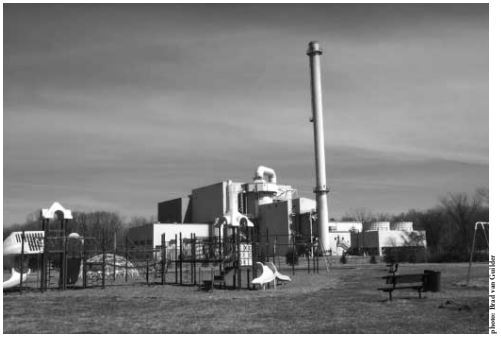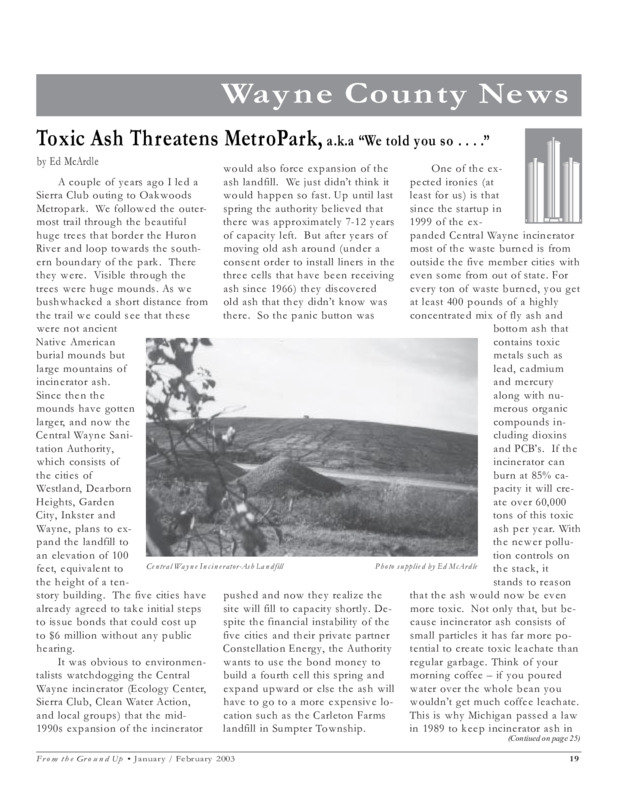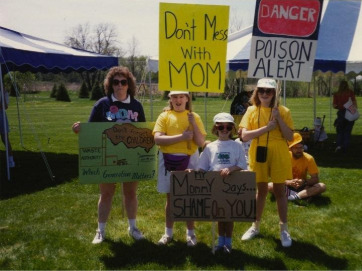Spotlight on the Central Wayne Incinerator Campaign
Cheryl Graunstadt's environmental activism began the day she received a letter from the principal of her children’s elementary school in 1991. It informed her and other parents that Cooper Elementary School, built in 1963, sat on top of an old industrial landfill. The school was awaiting soil testing from the backlogged Department of Natural Resources, but in the meantime, it told parents that Cooper was still a safe place for children to learn and play. Graunstadt wasn’t so sure. She and a friend went to investigate for themselves. When they arrived at the playground, they discovered pieces of broken glass rising from the gravel and, behind the property, an orange-colored slime. Graunstadt went to work organizing other concerned parents to sound the alarm, first locally and then nationally. Within a year, the administrators agreed to relocate students to a new school.
Graunstadt soon learned that Westland wasn’t the only city in the area exposing children to toxic waste. Less than ten miles away in Dearborn Heights, a massive municipal waste incinerator sat adjacent to an elementary school playground.
The Central Wayne incinerator had been authorized by the Sanitation Authority (CWSA) in 1961 to serve five Wayne County municipalities: Dearborn Heights, Garden City, Inkster, Wayne and Westland. By the 1990s, it had nearly tripled its capacity.
Several years after the closure of her children’s elementary school, Graunstadt set her sights on closing the Central Wayne incinerator. She was joined by a coalition of environmental organizations, including the Ecology Center, the Southeast Michigan Group of the Sierra Club, and Clean Water Action. Together this coalition informed community members about the dangers of the incinerator, pressured the local governments of the five participating cities to end their contracts with CWSA, lobbied CWSA officials to transition away from incineration, and made their case to the press through multiple interviews and op-eds. As a result of both public and financial pressure, the Central Wayne incinerator closed on Earth Day, 2004.
Central Wayne was one of many municipal waste incinerators built in the state during the latter half of the 20th century, in addition to the thousands of smaller onsite incinerators that were built by school districts, hospitals, and corporations. Proponents of incineration saw it as an effective way to stem the overflow of landfills and to turn waste into local sources of heat and electricity. Opponents pointed to its malignant environmental and health impacts, including increased rates of cancer and asthma. Ann Arbor residents living next to Pittsfield Elementary School in the early 1990s, for instance, were taken aback by the “black snow” that would collect on the playground next to the school’s incinerator. Not even the tallest smokestacks could keep communities safe from the larger municipal and medical waste incinerators whose toxic outputs often made their way into soil and groundwater. As a result, by the 1990s, incinerators were considered to be the largest source of mercury and dioxin pollution in the country.
The 1990s was also the decade that the Ecology Center began ramping up its involvement in campaigns to close municipal incinerators in places like Detroit, Dearborn Heights, Flint, Ypsilanti, Holcim and Jackson. Notably, the Ecology Center played a critical role in forcing the eventual 2019 closure of Detroit’s municipal incinerator, once the largest in the country. At the same time, the Ecology Center led multiple campaigns to shut down the state’s 157 medical waste incinerators, including hospital incinerators at the University of Michigan and Henry Ford Health System.
The Ecology Center was drawn to these campaigns because of both the broad environmental fallout that resulted from incineration as well as the fact that poorer communities and communities of color were often the ones who bore its worst health and environmental effects. The Ecology Center’s involvement in shutting down incinerators varied from campaign to campaign. In some cases, the Ecology Center focused on providing information to key stakeholders, such as producing a report that called into question the financial sustainability of Jackson County’s incinerator. In other cases, like the Central Wayne incinerator, they were more directly involved in organizing community members. In all their efforts to close the state’s incinerators, the Ecology Center worked to support local leaders like Westland’s Cheryl Graunstadt.
“Stop the Burn” at Central Wayne
As with most municipal incinerators in the state, Central Wayne’s was plagued with problems. The noise, described by one resident as “like a whining wood chipper,” drove many locals “nuts”. But noise was far from the most concerning issue. In May of 1989, the Department of Natural Resources declared the incinerator to be one of the largest producers of toxic ash in the state. The ash, often buried in landfills without adequate lining, began leaching toxic metals like cadmium and lead into the groundwater. In an Ecology Center newsletter, Ecology Center board member and Sierra Club staffer, Ed McArdle discussed the problems with the toxic ash and recounted seeing some of the piles of ash while hiking next to the Huron River.
The health and environmental damage caused by incineration can spread over vast areas; however, its most pernicious effects are often experienced by those closest to the facilities. In the case of Central Wayne, these were the residents living near the Dearborn Heights-Inkster border. According to 1990 census records, the neighborhoods immediately surrounding the facility were over 95% Black while the users of the incinerator were majority White. Compared to their wealthier neighbors, Dearborn Heights and Inkster residents also experienced higher rates of asthma as well as low birth weights and birth defects. These health factors were undoubtedly exacerbated by the incineration next door.
Despite the problems, CWSA announced in 1990 it would double the capacity of the incinerator. The decision was a bit of a head scratcher, and not just for environmental reasons. Compared to landfilling, incineration in the 1990s was an incredibly expensive method for disposing of waste, even with the energy capture that helped to defray its costs. In 1997, Central Wayne’s had a disposal fee (commonly referred to as a “tipping” fee) of $58 per ton. That price far outstripped the average fees paid in other regions in the midwest, which were often as low as $15. It turned out that residents in the five city region were paying enormous rates just to have their trash ejected into the air they breathe. This unjustifiable financial burden would become a central talking point for those engaged in the campaign to shut down the incinerator.
In 1995, the Ecology Center joined with Wayne County community members and other environmental organizations in the effort. In 1997, the Ecology Center issued a report that highlighted the environmental, health, and economic untenability of incineration as compared to alternatives. The report noted that recycling was a cost-competitive alternative to incineration. It pointed to the success of Recycle Ann Arbor as a model. That same year, the Ecology Center also testified to the Michigan Department of Environmental Quality (MDEQ) against the proposed expansion of the Central Wayne Incinerator. In their testimony, the Ecology Center discussed how the CWSA, in conducting their risk assessment of the expansion, neglected the dangers posed by the interactions of different airborne toxins as well as the potential dangers of compounds for which no long term studies existed. The Ecology Center made a further appeal to environmental justice, pointing out that the incinerator expansion “will differentially impact low income residents and people of color.”
In 1995, the Ecology Center joined with Wayne County community members and other environmental organizations in the effort. In 1997, the Ecology Center issued a report that highlighted the environmental, health, and economic untenability of incineration as compared to alternatives. The report noted that recycling was a cost-competitive alternative to incineration. It pointed to the success of Recycle Ann Arbor as a model. That same year, the Ecology Center also testified to the Michigan Department of Environmental Quality (MDEQ) against the proposed expansion of the Central Wayne Incinerator. In their testimony, the Ecology Center discussed how the CWSA, in conducting their risk assessment of the expansion, neglected the dangers posed by the interactions of different airborne toxins as well as the potential dangers of compounds for which no long term studies existed. The Ecology Center made a further appeal to environmental justice, pointing out that the incinerator expansion “will differentially impact low income residents and people of color.”
In 1995, the Ecology Center joined with Wayne County community members and other environmental organizations in the effort. In 1997, the Ecology Center issued a report that highlighted the environmental, health, and economic untenability of incineration as compared to alternatives. The report noted that recycling was a cost-competitive alternative to incineration. It pointed to the success of Recycle Ann Arbor as a model. That same year, the Ecology Center also testified to the Michigan Department of Environmental Quality (MDEQ) against the proposed expansion of the Central Wayne Incinerator. In their testimony, the Ecology Center discussed how the CWSA, in conducting their risk assessment of the expansion, neglected the dangers posed by the interactions of different airborne toxins as well as the potential dangers of compounds for which no long term studies existed. The Ecology Center made a further appeal to environmental justice, pointing out that the incinerator expansion “will differentially impact low income residents and people of color.”
The testimony and the coalition's early efforts could not stop the expansion which began in 1998 after CWSA struck a 35 year contract with Central Wayne Energy Recovery LP. Nevertheless, the “Stop the Burn” coalition continued to make their case to the public and city governments. Graunstadt, who in 2001 won a seat on Westland’s City Council, appealed to her constituents' pocket books, arguing that Westland residents shouldn’t be on the hook for paying for any part of the expansion or future repairs, "a debt” she said “that never seems to end." The Ecology Center and Clean Water Action supported Graunstadt’s effort in Westland by organizing a campaign that sent over 400 constituent letters to Westland’s mayor and city council, encouraging them to shut down the incinerator. In a 2019 interview, Ed McArdle of the Sierra Club explained that the strategy of convincing the five cities to take their trash elsewhere proved to be the death knell of the already financially struggling incinerator.
In May of 2003, as the incinerator teetered on the edge of financial collapse, the Ecology Center’s Mike Garfield and Brad van Guilder along with McArdle met with CWSA Executive Director Steve Aynes. They tried to convince Aynes to work with the bondholders to transform the incinerator facility into a garbage transfer and recycling station. But before any decision could be reached, CWERLP announced that they had defaulted on the $80 million in bonds they had been issued to expand the facility. The announcement brought about the abrupt closure of the incinerator.
The coalition knew that the closure might only be temporary. In early December, 2003, MDEQ held a public review meeting about a proposed revision to the permit of the cash-strapped incinerator that would allow the company to burn scrap plastic in addition to the garbage collected from the five cities. Representatives from the Ecology Center, the Windsor Essex County Environment Committee, and the Sierra Club as well as residents of Inkster came to the meeting to voice their opposition to the proposed permit. The permit fight became moot, however, once Waste Management purchased the assets of the bankrupted CWERLP in June of 2004. And, less than a year later, construction crews began working to dismantle the 225 ft smoke stack that had spewed toxic smoke into Wayne county for so many years.
The Big Picture
The Ecology Center and their activist partners have had varying degrees of success in shutting down the state’s incinerators. Through their work with Health Care Without Harm, the Ecology Center helped to get rid of the state’s 157 medical waste incinerators by 2005. In Jackson County, the Ecology Center supported local activists like Travis Fojtasek in lobbying for the closure of that county’s incinerator which eventually closed in 2013. Other facilities, like Flint’s Genesee Power Station wood waste incinerator, the Ypsilanti Community Utilities Authority’s sludge incinerator, and Holcim’s cement incinerator continue to operate, despite opposition from the Ecology Center and local activists.
The successful closure of the Central Wayne facility highlights an important model for activists. In Central Wayne, the Ecology Center worked with local activists to not only expose the environmental injustices of waste incineration, but they made economic appeals that were convincing to many residents and city officials across the political spectrum. They also highlighted the injustices that communities of color and poorer communities have and continue to face because of waste disposal practices.
Written by Alex Honold (honold@umich.edu), August 2021



